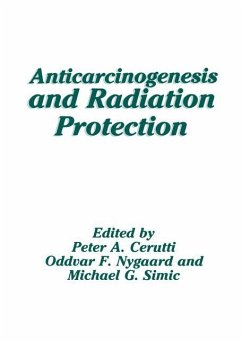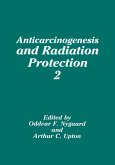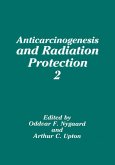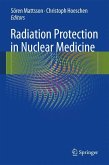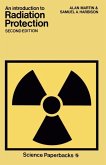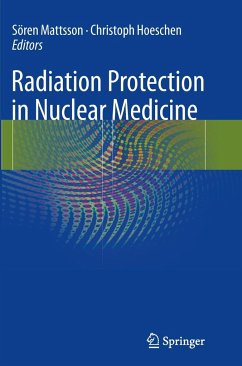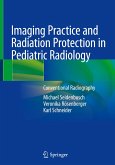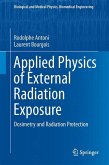Anticarcinogenesis and Radiation Protection
Herausgegeben:Cerutti, Peter
Anticarcinogenesis and Radiation Protection
Herausgegeben:Cerutti, Peter
- Broschiertes Buch
- Merkliste
- Auf die Merkliste
- Bewerten Bewerten
- Teilen
- Produkt teilen
- Produkterinnerung
- Produkterinnerung
This book is based on the invited and contributed papers presented at the 2nd International Conference on Anticarcinogenesis and Radiation Protection held at the National Bureau of Standards, Gaithersburg, Maryland, USA, on March 8-12, 1987. The conference documented developments that have taken place in areas that were addressed during the first conference in 1982. A number of new topics, such as biological response modifiers, were included because of their emerging relevance to anticarcinogenesis and radiation protection. The organization of the material in this book does not follow the…mehr
Andere Kunden interessierten sich auch für
![Anticarcinogenesis and Radiation Protection 2 Anticarcinogenesis and Radiation Protection 2]() O.F. Nygaard / A.C. Upton (eds.)Anticarcinogenesis and Radiation Protection 2190,99 €
O.F. Nygaard / A.C. Upton (eds.)Anticarcinogenesis and Radiation Protection 2190,99 €![Anticarcinogenesis and Radiation Protection 2 Anticarcinogenesis and Radiation Protection 2]() Anticarcinogenesis and Radiation Protection 2110,99 €
Anticarcinogenesis and Radiation Protection 2110,99 €![Radiation Protection in Nuclear Medicine Radiation Protection in Nuclear Medicine]() Radiation Protection in Nuclear Medicine74,99 €
Radiation Protection in Nuclear Medicine74,99 €![An Introduction to Radiation Protection An Introduction to Radiation Protection]() HarbisonAn Introduction to Radiation Protection42,99 €
HarbisonAn Introduction to Radiation Protection42,99 €![Radiation Protection in Nuclear Medicine Radiation Protection in Nuclear Medicine]() Radiation Protection in Nuclear Medicine81,99 €
Radiation Protection in Nuclear Medicine81,99 €![Imaging Practice and Radiation Protection in Pediatric Radiology Imaging Practice and Radiation Protection in Pediatric Radiology]() Michael SeidenbuschImaging Practice and Radiation Protection in Pediatric Radiology111,99 €
Michael SeidenbuschImaging Practice and Radiation Protection in Pediatric Radiology111,99 €![Applied Physics of External Radiation Exposure Applied Physics of External Radiation Exposure]() Rodolphe AntoniApplied Physics of External Radiation Exposure168,99 €
Rodolphe AntoniApplied Physics of External Radiation Exposure168,99 €-
-
-
This book is based on the invited and contributed papers presented at the 2nd International Conference on Anticarcinogenesis and Radiation Protection held at the National Bureau of Standards, Gaithersburg, Maryland, USA, on March 8-12, 1987. The conference documented developments that have taken place in areas that were addressed during the first conference in 1982. A number of new topics, such as biological response modifiers, were included because of their emerging relevance to anticarcinogenesis and radiation protection. The organization of the material in this book does not follow the conference program; rather, we have attempted to provide a different sequence for didactic reasons. The aim of the conference, which is reflected in this book, was to promote further development of mechanistic approaches to cancer prevention and treatment based on recent progress in molecular biology and free radical chemistry. At the basis of carcinogenesis lie changes in the dynamics of growthand differentiation of specific cell subpopulations in the target tissue. 'These changes are brought about by selective toxicity and modulation of gene expression that are induced by xenobiotic carcinogens and affected by physiological and genetic factors. The book deals with oxidative stress and molecular damage caused by radiation and chemical pro-oxidants and their role in carcinogenesis, and it discusses mechanisms of deregulation of the expression of oncogenes and other genes involved in carcinogenic initiation and promotion.
Produktdetails
- Produktdetails
- Verlag: Springer / Springer US / Springer, Berlin
- Artikelnr. des Verlages: 978-1-4615-6464-5
- 1987
- Seitenzahl: 524
- Erscheinungstermin: 3. Mai 2012
- Englisch
- Abmessung: 254mm x 178mm x 29mm
- Gewicht: 986g
- ISBN-13: 9781461564645
- ISBN-10: 1461564646
- Artikelnr.: 40772449
- Herstellerkennzeichnung
- Books on Demand GmbH
- In de Tarpen 42
- 22848 Norderstedt
- info@bod.de
- 040 53433511
- Verlag: Springer / Springer US / Springer, Berlin
- Artikelnr. des Verlages: 978-1-4615-6464-5
- 1987
- Seitenzahl: 524
- Erscheinungstermin: 3. Mai 2012
- Englisch
- Abmessung: 254mm x 178mm x 29mm
- Gewicht: 986g
- ISBN-13: 9781461564645
- ISBN-10: 1461564646
- Artikelnr.: 40772449
- Herstellerkennzeichnung
- Books on Demand GmbH
- In de Tarpen 42
- 22848 Norderstedt
- info@bod.de
- 040 53433511
Free Radical Mechanisms.- The Involvement of Free Radicals in Chemical Carcinogenesis.- Autoxidation and Enzymatic Oxidation of Unsaturated Lipids.- Electron vs. H-Atom Transfer in Chemical Repair.- Radiation Induced Reactions of Glutathione with Oxygen and Their Possible Role in Biological Systems.- Potential Limitation to Hydrogen Atom Donation as a Mechanism of Repair in Chemical Models of Radiation Damage.- Mechanisms of Inactivation of Oxygen Species by Carotenoids.- Inhibition of Autoxidation by Vitamin E and Bilirubin.- Oxygen Species in Carcinogenesis.- The Role of Active Oxygen and the Metabolism of Arachidonic Acid in The Formation of Clastogenic Factor by Human Monocytes.- Clastogenic Factors, A Link Between Chronic Inflammation and Carcinogenesis.- Role of Eicosanoids in Tumor Cell-Platelet-Endothelial Cell Interactions.- The Involvement of Peroxyl Free Radicals in Tumor Initiation and Promotion.- Amplification of Tissue Peroxides in Disease.- Peroxisome Proliferation-Related Oxidative Stress and Hepato-Carcinogenesis.- Hydroxyl Free Radical Mediated Strand Breaks in PBR322 Plasmid DNA.- Radiation-Like Modification of DNA and H2O2 Formation by Activated Human Polymorphonuclear Leukocytes (PMNs).- Mitochondrial DNA Damage During Mitochondrial Lipid Peroxidation.- Mitigation of Singlet Oxygen (1?gO2) Damage in Biological Systems.- Reactive Oxygen Species are Mutagenic to Mammalian Cells.- Enzymatic Repair of DNA Damage.- The Expression of Bacterial DNA Alkylation Repair Enzymes in Mer Human Cells.- DRPase, A New Activity in the DNA Base Excision Repair Pathway.- Mechanism of Action of Exonuclease III From Escherichia coli.- The Isolation and Preliminary Characterization of Endonuclease VIII from Escherichia coli.- Incorporation of Dihydrothymidine and itsTriphosphate During DNA Replication: An Implication for the Biological Consequence of Thymine C5-C6 Bond Saturation.- Oxidative Damage: DNA Repair and Inducible Resistance.- 5-Hydroxymethyluracil in Cellular DNA is Repaired and Sensitizes Cells to Inhibitors of Poly(ADP-Ribose) Synthesis.- Metabolic Protection Against Rapid Death Induced by High Level DNA Damage.- Tumor Promotion and Progression.- Tumor Promotion: A Problem of Differential Responses of Normal and Neoplastic Cells to Trophic Stimuli.- Implication of Superoxide Radical Anion in Promotion of Neoplastic Transformation in Mouse JB6 Cells by TPA.- Expression of Oxidant Stress-Related Genes in Tumor Promotion of Mouse Epidermal Cells JB6.- Activation of Organic Hydroperoxide Tumor Promoters to Free Radicals in Target Cells.- In Vivo Stimulation of Oxy Radicals by Mouse Skin Tumor Promoters.- UVB Prevention of Mouse Skin Tumor Induction by the Initiation-Promotion Protocol.- A Possible Role for Free Radicals in Tumor Progression.- Differential Effects of 12-0-Tetradecanoylphorbol-13-acetate (TPA) on Normal, Initiated and Transformed Cells of a Single Mouse Keratinocyte Lineage.- Oncogenes and Malignant Transformation of Human Keratinocytes.- Chemoprevention.- Nucleophiles as Anticarcinogens.- Protection from N-Nitrosodimethylamine Mediated Liver Damage by Indole-3-Carbinol, and Correlation with Nucleophilic Index Value.- Ozone Carcinogenesis and Co-Carcinogenesis and Its Prevention.- Exercise Training Effects on Mitochondrial Enzyme Activity, Ubiquinones and Vitamin E.- Cancer Mortality Inversely Related to Plasma Levels of Antioxidant Vitamins.- Beta-Carotene and Chemoprevention of Cancer.- Cancer Chemoprevention with Vitamin A and Beta-Carotene in Populations at High-Risk for Lung Cancer.- Anticarcinogenic Actions of Protease Inhibitors.- Possible Mechanisms of Action of the Anticarcinogenic Protease Inhibitors.- Dietary Choline Deficiency as a New Model to Study the Possible Role of Free Radicals in Acute Cell Injury and in Carcinogenesis.- Inhibition of Genotoxicity by Diallyl Sulfide and Structural Analogues.- Physiologic Anticarcinogenesis. Effects of Stable Strontium on Metastatic Bone Disease.- Radiation Damage and Protection.- Radiation vs Chemical Damage to DNA.- Radon-Induced Transformation.- Radiation-Induced Neoplastic Transformation of Human Cell Hybrids.- Multiple Oncogene Activation in a Radiation Carcinogenesis Model.- Radiation and Asbestos Fibers: Interaction and Possible Mechanism.- Role of Peroxidase in Stimulation of the Pentose Cycle of A549 Cells by Aerobic Irradiation.- Toxicity and Radioprotective Efficacy of Bis (3, 5-Diisopropylsalicylato) Copper II and CuCl2.- Thiols as Anticarcinogens And Radioprotectors.- Modulation of Glutathione Levels and Metabolism.- Inhibition of Mutagenesis and Carcinogenesis by N-Acetylcysteine.- Protective Effects of Thiols on Carcinogenesis Induced in Rats by 2-Acetylaminofluorene.- The Role of Thiols in Response to Radiation and Drugs.- The Role of Modification of DNA Damage in the Radioprotective Action of Aminothiols.- Radioprotection in Rat Spinal Cord with WR2721, WR77913 and WR3689 Following Cerebral Lateral Ventricular or Intracisternal Administration.- Production and Characterization of Monoclonal Antibodies to Thiol-Modified Glutathione.- Cancer Therapy.- Induction of Differential Hypoxia in Tissues and Its Implications for Therapy.- Radioprotection In Vivo: Cellular Heterogeneity and Fractionation.- Pharmacological Interference with DNA Repair.- DNA Strand Scission by Activated Bleomycin Group Antibiotics.- Prospects for Liposomes as Drug Carriers.- The Inhibitory Effect of Parvovirus H-1 on Cultured Human Cancer Cells or Transformed Cells.- Biological Response Modifiers.- Evaluation of Immunomodulatory and Therapeutic Properties of Biological Response Modifiers: A Comparison of Preclinical and Clinical Studies.- Circumvention of Biologic Diversity of Cancer Metastasis.- Comparison of Therapeutic Potential of Cytokines.- Clinical Trials Using Monoclonal Antibodies.- Chemoprophylaxis by Interferons or Inducers Against Chemical Carcinogenesis.
Free Radical Mechanisms.- The Involvement of Free Radicals in Chemical Carcinogenesis.- Autoxidation and Enzymatic Oxidation of Unsaturated Lipids.- Electron vs. H-Atom Transfer in Chemical Repair.- Radiation Induced Reactions of Glutathione with Oxygen and Their Possible Role in Biological Systems.- Potential Limitation to Hydrogen Atom Donation as a Mechanism of Repair in Chemical Models of Radiation Damage.- Mechanisms of Inactivation of Oxygen Species by Carotenoids.- Inhibition of Autoxidation by Vitamin E and Bilirubin.- Oxygen Species in Carcinogenesis.- The Role of Active Oxygen and the Metabolism of Arachidonic Acid in The Formation of Clastogenic Factor by Human Monocytes.- Clastogenic Factors, A Link Between Chronic Inflammation and Carcinogenesis.- Role of Eicosanoids in Tumor Cell-Platelet-Endothelial Cell Interactions.- The Involvement of Peroxyl Free Radicals in Tumor Initiation and Promotion.- Amplification of Tissue Peroxides in Disease.- Peroxisome Proliferation-Related Oxidative Stress and Hepato-Carcinogenesis.- Hydroxyl Free Radical Mediated Strand Breaks in PBR322 Plasmid DNA.- Radiation-Like Modification of DNA and H2O2 Formation by Activated Human Polymorphonuclear Leukocytes (PMNs).- Mitochondrial DNA Damage During Mitochondrial Lipid Peroxidation.- Mitigation of Singlet Oxygen (1?gO2) Damage in Biological Systems.- Reactive Oxygen Species are Mutagenic to Mammalian Cells.- Enzymatic Repair of DNA Damage.- The Expression of Bacterial DNA Alkylation Repair Enzymes in Mer Human Cells.- DRPase, A New Activity in the DNA Base Excision Repair Pathway.- Mechanism of Action of Exonuclease III From Escherichia coli.- The Isolation and Preliminary Characterization of Endonuclease VIII from Escherichia coli.- Incorporation of Dihydrothymidine and itsTriphosphate During DNA Replication: An Implication for the Biological Consequence of Thymine C5-C6 Bond Saturation.- Oxidative Damage: DNA Repair and Inducible Resistance.- 5-Hydroxymethyluracil in Cellular DNA is Repaired and Sensitizes Cells to Inhibitors of Poly(ADP-Ribose) Synthesis.- Metabolic Protection Against Rapid Death Induced by High Level DNA Damage.- Tumor Promotion and Progression.- Tumor Promotion: A Problem of Differential Responses of Normal and Neoplastic Cells to Trophic Stimuli.- Implication of Superoxide Radical Anion in Promotion of Neoplastic Transformation in Mouse JB6 Cells by TPA.- Expression of Oxidant Stress-Related Genes in Tumor Promotion of Mouse Epidermal Cells JB6.- Activation of Organic Hydroperoxide Tumor Promoters to Free Radicals in Target Cells.- In Vivo Stimulation of Oxy Radicals by Mouse Skin Tumor Promoters.- UVB Prevention of Mouse Skin Tumor Induction by the Initiation-Promotion Protocol.- A Possible Role for Free Radicals in Tumor Progression.- Differential Effects of 12-0-Tetradecanoylphorbol-13-acetate (TPA) on Normal, Initiated and Transformed Cells of a Single Mouse Keratinocyte Lineage.- Oncogenes and Malignant Transformation of Human Keratinocytes.- Chemoprevention.- Nucleophiles as Anticarcinogens.- Protection from N-Nitrosodimethylamine Mediated Liver Damage by Indole-3-Carbinol, and Correlation with Nucleophilic Index Value.- Ozone Carcinogenesis and Co-Carcinogenesis and Its Prevention.- Exercise Training Effects on Mitochondrial Enzyme Activity, Ubiquinones and Vitamin E.- Cancer Mortality Inversely Related to Plasma Levels of Antioxidant Vitamins.- Beta-Carotene and Chemoprevention of Cancer.- Cancer Chemoprevention with Vitamin A and Beta-Carotene in Populations at High-Risk for Lung Cancer.- Anticarcinogenic Actions of Protease Inhibitors.- Possible Mechanisms of Action of the Anticarcinogenic Protease Inhibitors.- Dietary Choline Deficiency as a New Model to Study the Possible Role of Free Radicals in Acute Cell Injury and in Carcinogenesis.- Inhibition of Genotoxicity by Diallyl Sulfide and Structural Analogues.- Physiologic Anticarcinogenesis. Effects of Stable Strontium on Metastatic Bone Disease.- Radiation Damage and Protection.- Radiation vs Chemical Damage to DNA.- Radon-Induced Transformation.- Radiation-Induced Neoplastic Transformation of Human Cell Hybrids.- Multiple Oncogene Activation in a Radiation Carcinogenesis Model.- Radiation and Asbestos Fibers: Interaction and Possible Mechanism.- Role of Peroxidase in Stimulation of the Pentose Cycle of A549 Cells by Aerobic Irradiation.- Toxicity and Radioprotective Efficacy of Bis (3, 5-Diisopropylsalicylato) Copper II and CuCl2.- Thiols as Anticarcinogens And Radioprotectors.- Modulation of Glutathione Levels and Metabolism.- Inhibition of Mutagenesis and Carcinogenesis by N-Acetylcysteine.- Protective Effects of Thiols on Carcinogenesis Induced in Rats by 2-Acetylaminofluorene.- The Role of Thiols in Response to Radiation and Drugs.- The Role of Modification of DNA Damage in the Radioprotective Action of Aminothiols.- Radioprotection in Rat Spinal Cord with WR2721, WR77913 and WR3689 Following Cerebral Lateral Ventricular or Intracisternal Administration.- Production and Characterization of Monoclonal Antibodies to Thiol-Modified Glutathione.- Cancer Therapy.- Induction of Differential Hypoxia in Tissues and Its Implications for Therapy.- Radioprotection In Vivo: Cellular Heterogeneity and Fractionation.- Pharmacological Interference with DNA Repair.- DNA Strand Scission by Activated Bleomycin Group Antibiotics.- Prospects for Liposomes as Drug Carriers.- The Inhibitory Effect of Parvovirus H-1 on Cultured Human Cancer Cells or Transformed Cells.- Biological Response Modifiers.- Evaluation of Immunomodulatory and Therapeutic Properties of Biological Response Modifiers: A Comparison of Preclinical and Clinical Studies.- Circumvention of Biologic Diversity of Cancer Metastasis.- Comparison of Therapeutic Potential of Cytokines.- Clinical Trials Using Monoclonal Antibodies.- Chemoprophylaxis by Interferons or Inducers Against Chemical Carcinogenesis.

